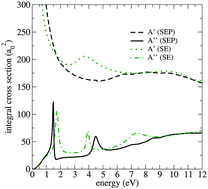Negative ion states of 5-bromouracil and 5-iodouracil
Abstract
The valence anion states of the potential radiosensitisers 5-bromouracil and 5-iodouracil were investigated through elastic scattering calculations. These compounds have rich spectra of negative ion states that trigger off different mechanisms for dissociative electron attachment. For each molecule, we obtained a bound π* anion, two π* shape resonances and a low lying σ* anion state, in addition to a dipole-bound state (the latter was obtained using bound-state techniques). The σ* anion, formed by electron attachment to an anti-bonding carbon-halogen orbital, was found to have resonant character in 5-bromouracil, and bound-state character in 5-iodouracil. The present calculations place the σCBr* resonance around 0.7 eV, considerably below the energy inferred from the electron transmission data (1.3 eV). The signature of this anion state, not evident in the measurements, would be obscured by the large background arising from the dipolar interaction, not by the strong signature of the π2*, as presumed. Our results support the π2* resonance as a precursor state to dissociative electron attachment around 1.5 eV in both 5-bromouracil and 5-iodouracil, while the interplay among π1*, σ* and dipole-bound states would be expected close to 0 eV. We also discuss the suppression of the hydrogen elimination channels in these species.


 Please wait while we load your content...
Please wait while we load your content...